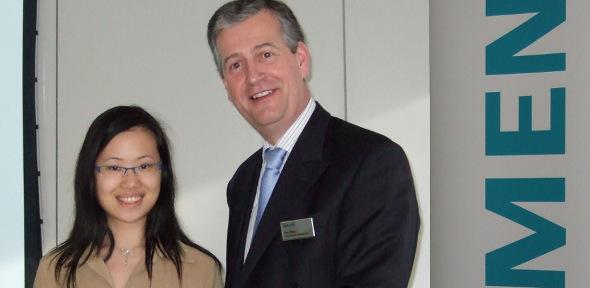
Irene Vidyanti, now a final year student at the Department, received a Sir William Siemens medal from Tom Young, Chief Executive of Siemens plc, at a ceremony held at Siemens' new corporate headquarters at Frimley, Surrey. Irene was nominated for the award in recognition of her excellent project work in the third year coupled with her impressive progress in other parts of the Electrical Engineering course. Irene's third year projects are image processing and data analysis.
Image processing project
The project aim was to find an image compression technique that produces compressed images with the best subjective quality. In image compression, the goal is to reduce as much information redundancy in the image as possible for efficient storage or transmission. A well-known and commonly used image compression standard is JPEG.
Irene's project focussed mainly on transform coding, in which knowledge of the application is used to choose which information to discard for compression. First, several signal representation/transform methods were explored. These transforms were then followed by quantization (in which a range of values are compressed to a single value, for example, in the reduction of colours necessary to represent a digital image) and entropy coding (in which rarely occurring patterns carrying more information are coded with many bits and common patterns which impart less information are coded with few bits).
Data analysis project
The project was an investigation into methods of analysing data. Several data analysis methods were explored and applied on several data sets, such as the temperature of ice in the North Pole, or the number of population of lynx in a certain area. Both parametric methods (in which model structure is specified prior to the analysis) and non-parametric methods (in which the model structure is determined from the data) were investigated.
Among the non-parametric methods Fourier Transform was found to be an efficient tool to compute the frequency of the signal. However, its performance degrades significantly as noise level becomes comparable to the signal. Different filters were designed to filter out noise. As each filter type has its own characteristics choice of filter type depends on the output requirements. There are also trade-offs to be considered such as computational cost. Data smoothing, which is useful to extract long-run trends in the data, was also investigated.
Among the parametric models Bayesian analysis was found to result in a more accurate probabilistic estimation if there was strong prior information. The use of maximum entropy regularization in deconvolution (in which additional information about the solution is introduced in the process of reversing the effect of convolution to the original data) is studied and its robustness under noise assessed. Its use in practical applications, such as optical deconvolution (deblurring of an image or image restoration), was also investigated.
The Siemens Medal was first inaugurated in 1883; at that time only one was given annually. This year 18 of the leading Universities in the UK were each invited to nominate a student to receive one of these prestigious awards. The 2 inch bronze medals are struck at the Royal Mint as replicas of the original medal first awarded in 1883, and the award includes a generous cheque. The Siemens company offers these awards to raise the profile of science and technology, and to encourage students into the profession of electrical and electronic engineering.

